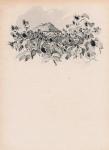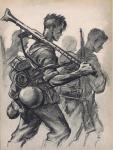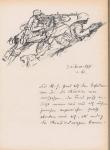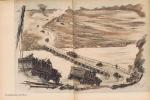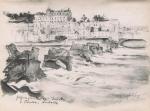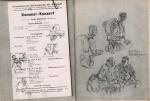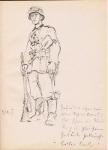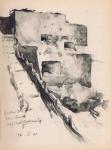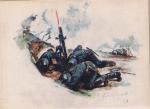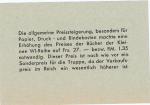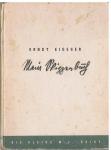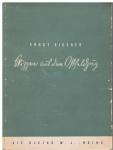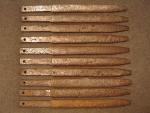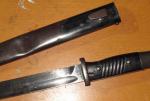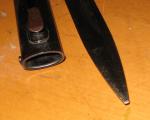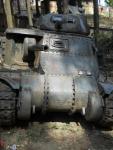-
Posts
1,869 -
Joined
-
Last visited
-
Days Won
7
Content Type
Profiles
Forums
Blogs
Gallery
Events
Store
Everything posted by Spasm
-
I've included a small selection of the pictures, there are many more. This book contains images of a strong German army on the advance, ruined enemy defences, bombarded towns and a general feeling of the advance and victory. There are a few also a few hints as to Eigener's feelings towards the local population and the surrounding countryside.
-
Both are part of the Die kleine W. J.-Reihe book series, can be easily found and are fairly inexpensive. The 1942 edition being slightly rarer and more costly. They are small (just under A5 size) but bursting with vitality and showing an artist with a fantastic skill to capture both action and mood. The books contain mostly black and white pencil sketches with a few watercolours. There are hardly any narrative comments other than a 'Vorwort' by Helmut Jahn in each book. Eigener lets the pictures speak for themselves. 1940/41 - "Mein Skizzenbuch" Interestingly my copy of Eigener's first book still has an original loose printed slip inside which basically is a note explaining that although publishing costs are rising the prices for the books are kept low for the troops:
-
Hans Liska (1907-1983) is recognised worldwide for his WW2 sketchbooks. His first edition printed sketch books are expensive and coveted collector items. Perhaps a lesser known artist from that period who also documented WW2 with his pencil was Ernst Eigener. Eigener was a member of Propagandakompanie 637 formed in 1939 in Breslau (Wroclaw). PK 637 was attached to the 6th Army that fought it's way through Belgium, France and then turned its attention Eastwards with operation Barbarossa. Eigener battled along with the army deep into Russia and ultimately onto Stalingrad. Two of Ernst Eigener's 'skizzenbuchs' (sketchbooks) were published during the war. The first in 1941 that contains work from the Westfeldzug called 'Mein Skizzenbuch' and the second in 1942 that includes his artwork from the Russian campaign 'Skizzen aus dem Ostfeldzug'.
-
Gents A note before I start this thread. I've tried and tried to get this into an article and then as a blog, but I just cannot get the pictures to load into the text as anything other than a very small thumbnail that doesn't expand when clicked on. Not a lot of use if the article is about the artwork. So, extremely sorry guys, even when I followed the instructions (that worked previously when I tried them some months ago), I still couldn't make them work. I gave up as I was getting close to throwing the computer out of the window and shouting at the admin staff (her indoors). So, as it's written, I admit not very well, you can read it here. But it's the pictures that are the interesting bit. If you'd like to see more of Ernst's sketches, let me know and I'll scan some more. Right, start.......but let me get to the end before you comment or you'll ruin the flow
-
Last visit to the post office to send off to the old kingdom of drones with batting averages of .25 (whatever that is) I was quoted £72! I said I could take it there myself for that amount, but was told that it was their special service and that it would actually arrive before I'd posted it. I spotted their mistake, declined their special service and went for the usual £26. They hadn't realised that if it arrived yesterday I wouldn't have been paid for it yet.
-
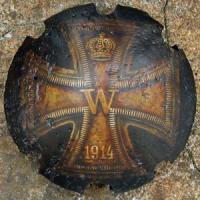
HJ: Hitler-Jugend HJ Knives
Spasm replied to Jock Auld's topic in Germany: Third Reich: Uniforms, Headwear, Insignia & Equipment
-

helmet opinions
Spasm replied to blueman's topic in Great Britain: Militaria: Badges, Uniforms & Equipment
Am I correct in saying the rifle alone is worth that sort of dough. Given the impression of the spear and plate wouldn't this lot have sold for much more even it was close to being correct. -

HJ: Hitler-Jugend HJ Knives
Spasm replied to Jock Auld's topic in Germany: Third Reich: Uniforms, Headwear, Insignia & Equipment
There's stuff that needs rescuing and there's stuff that doesn't. Rescuing, if needed, should be done carefully and with advice from people who have learned from their errors. Here's a matching numbers bayo that I rescued from being rescued. Well used, dented scabbard with the usual 'door ding', scratches, hammering to the end, loads of blueing gone and best of all, the point has been squared off to make a screwdriver tip. Good tool. -

HJ: Hitler-Jugend HJ Knives
Spasm replied to Jock Auld's topic in Germany: Third Reich: Uniforms, Headwear, Insignia & Equipment
Yep, understand that. Why a mint knife? Mint weapons never saw the light of day. I get that collectors would want mint dress bayonets and daggers but weapons? Mint stuff is nice but I'd rather have something that has a 'been there' hardcase attitude with some history rather than something kept in a drawer for 100 years. Sort of doesn't seem right that collectors let medals get all black when they were meant to be shiny when in use and weapons to be totally unused. I suppose it helps us poorer people to buy up all the cheap scratched, sharpened and dented war gear and all those well loved shiny awards. Keep up the good work you rich people. -

What would have been the outcome of WWI if......
Spasm replied to Paul C's topic in The Great War 1914 to 1918
What would have been the outcome of WW1 if America had not joined the fight? I suppose it's what you deem to mean 'the fight'. Had the US already joined 'the fight' by choosing to supply materials and loans to the Allies? The Pope had asked her not to supply any of the belligerents and to help stop the war. But the US would not allow all this actual and potential business to go somewhere else, which it would have, probably to Canada, Australia or Argentina. America actually supplied the Germans with materials during the war until it was mostly turned back by the British naval blockade and as American public opinion changed. They were actually accused of 'filling both pockets with both hands' during the early stages of the war. And why not? They were a pacifist economic nation and saw the war as a sharp skirmish 'way over there'. The pacifism stance narrowly re-elected Wilson in 1916. The US had already seen the brutality by the Germans in Belgium and France, the burning of Louvain, the execution of the nurse Edith Cavell, they had seen the Lusitania and the Arabic sank. The German promises to not sink ships without warnings broken again with the Anaconda and the Sussex. The delay tactics by the Germans gave them enough time to build the great fleets of submarines they thought they needed to strangle the Allies led to more and more merchant ships being sunk without warning. Then the Zimmermann telegram that tried to keep the American troops on the Mexican border. How could the US stay out? Not now. Then there's the actual fighting and the physical defeat of Germany. In the 9 months after America's declaration of war on Germany she has battle ready 175,000 troops in the lines. In the same period from 1914 at the start of the war Britain had 660,000 troops in the line. A lot easier to get British troops across the Channel rather than from all over America and across the Atlantic. By the end of the war the US had 1,500,000 troops in France. Although Ludendorff and Hindenburg have a few conflicting 'memories' after the end of the war. Particularly the 'stab in the back' theories that both dreamt up at hearings and in memoirs. Ludendorff's 'Black day for the German army' at Amiens in August led him to conclude on the 8th that the war had to be ended. He ordered the German army to hold their positions so that negotiations would be more favourable. The army continued to fall back under pressure. On 29th September Ludendorff advises the Kaiser to seek armistice. On 3rd October Hindenburg does the same. The German Spring and Summer offensives had failed. Helped in part by American troops it is true. The Germans were bled white, the offensives were their last chance of winning. In mid 1918 the flu epidemic was causing more casualties than combat, the majority of the 300,000 troop replacements were from students and older men, civilians were starving, more POWs were taken in 1918 than in any other period of the war. The German Nation was finished. The surrender came while the majority of the front line was still in foreign counties. Bulgaria surrendered in September, Turkey and Austria-Hungary has surrendered in early November. The Navy, sat idle for most of the war due to the blockade, mutinied rather than engage in the proposed suicide attack ordered in October. The sailor's morale had been low since the first uprising in August 1917. Without doubt the American troops aided the Allies victories in stopping the German's offensives in 1918. But without them the Allies would have prevailed. It was the British and French attacks that broke the already broken German army. The blockade did for Germany, something they tried (with submarines) but failed to achieve on the Allies. And once Alvin York sorted it all out on 8th October it was just an easy mop up operation after that. So the answer is that the Germans would have lost in either scenario. They lost when their plan to knock France out of the war and then take on the Russians failed because they annoyed the British by beating up the Belgians. -
Two cool dudes there. I agree that one of them is looking a bit pale. You need to eat more vegetables Colin.
-

RAF pilot research
Spasm replied to jim lemon's topic in Great Britain: Militaria: Badges, Uniforms & Equipment
Jim Looks like a DFC ribbon which assuming the owners name is on the label (pics are a bit small for me to see) you should be able to find him in the London Gazette. http://www.london-gazette.co.uk/search Some WW2 records are kept on Forces War Records which will also have census records, you will have to pay to see these records http://www.forces-war-records.co.uk/records.asp?gclid=CKWw0eao6rwCFUcTwwod6koA6Q Gallantry awards are available in the National Archives, some are available to see on line but some have to be ordered at a small charge http://www.nationalarchives.gov.uk/ RAF records for WW2 may be available through Veterans UK - depends if veteran is alive and will cost about £30 and a few months of waiting http://www.veterans-uk.info/service_records/raf.html On the National Archives there is a section to employ a researcher who will find all there is to know (legally available) and will get things done a lot quicker too. They charge a set amount per day's work. Other Gents on here will have DFC records so worth checking if your man is actually entitled to the award rather than just having a ribbon sewn on to a uniform. Spect they'll be other inputs from others as well. Good luck and keep us updated. -

It's not about your sister......
Spasm replied to Chris Boonzaier's topic in The Great War 1914 to 1918
Ulsterman's "Die you YankeeF&:ck"! Is the same in Spanglish. -
Great bits of kit. These were originally designed without a stock. A few units in the African and Italian campaigns actually took the stocks off.



